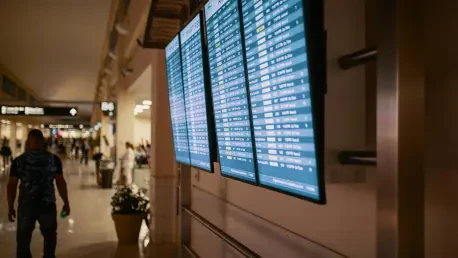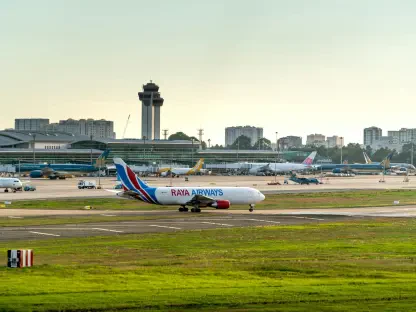Have you ever found yourself stranded at an airport, staring at a departure board filled with red “delayed” notices, wondering how a political deadlock could ground your plans and disrupt your life? As of this year, a government shutdown stretching into its second month has unleashed chaos across U.S. airports, with thousands of flights delayed or canceled. From Newark to Miami, travelers are caught in a frustrating web of uncertainty, all tied to a critical shortage of air traffic controllers working without pay. This crisis isn’t just a minor inconvenience—it’s a stark reminder of how deeply federal operations underpin everyday life.
Why the Skies Are Stalled: The Shutdown’s Grip on Aviation
At the heart of this aviation nightmare lies a simple yet devastating truth: nearly 13,000 air traffic controllers, vital to the safety and flow of air travel, are either unpaid or absent due to financial strain. Their role in guiding planes through takeoffs, landings, and crowded airspace cannot be overstated, yet the ongoing shutdown has left them in limbo. This isn’t a new problem—there was already a shortage of about 3,000 controllers before the crisis hit—but the current situation has pushed the system to a breaking point.
The impact is starkly visible in the numbers. According to FlightAware, a single Sunday evening this month saw 4,295 delays and 557 cancellations across flights within, into, or out of the U.S. Compare that to pre-shutdown figures from earlier this year, when 69% of flights departed on time and only 2.5% were canceled, and the scale of disruption becomes clear. Major hubs like Newark, where delays often stretch to two or three hours, are hit hardest, but the ripple effects touch even smaller regional airports.
This story matters because air travel isn’t just about vacations or business trips—it’s an economic lifeline. Delays and cancellations disrupt supply chains, hinder commerce, and strain personal lives, all while a political stalemate in Washington shows no immediate signs of resolution. Understanding how this unfolded reveals the fragility of systems many take for granted.
Behind the Delays: A Workforce Under Pressure
In the control towers and regional centers of the Federal Aviation Administration (FAA), the human toll of the shutdown is palpable. Air traffic controllers, already understaffed, face immense personal hardship as paychecks stop coming. Some have resorted to calling in sick or skipping shifts entirely, not out of negligence but out of necessity to support their families. This absenteeism compounds the existing shortage, creating gaps in a system where precision and presence are non-negotiable.
The FAA, tasked with ensuring safety above all, has no choice but to slow down operations when staffing falls short. Fewer controllers mean fewer planes can be guided at once, leading to bottlenecks at key airports like Chicago O’Hare and Dallas Fort Worth. Safety remains the priority, but the cost is efficiency—travelers bear the brunt with missed connections and hours-long waits on the tarmac.
Aviation analytics firm Cirium points out that while many airports managed decent on-time performance earlier this month, the situation has deteriorated rapidly in recent weeks. The cascading effect is evident: a delay in Houston can disrupt a connecting flight in Denver, creating a domino effect across the nation. This isn’t just a staffing issue—it’s a systemic failure amplified by extraordinary circumstances.
Voices from the Front Lines: Insights and Warnings
U.S. Transportation Secretary Sean Duffy has emerged as a key figure in addressing this crisis, offering a window into the government’s response. Initially critical of controllers missing work, Duffy warned of potential firings but soon pivoted to a more empathetic stance. “These are people making tough choices to feed their families,” he recently stated, acknowledging the impossible bind faced by unpaid federal workers. His words underscore a shift toward understanding over punishment.
Duffy’s evolving perspective also comes with a grim forecast. He has cautioned that delays and cancellations will likely intensify as long as the shutdown persists, with understaffed control towers forced to prioritize caution over speed. This isn’t mere speculation—his warnings align with daily reports of growing disruptions at airports nationwide, painting a picture of an aviation network stretched thin.
Beyond official statements, industry experts echo the urgency. Analysts at Cirium note that the crisis, while initially manageable at some hubs, has now reached a tipping point. Their data suggests that without intervention, the strain on controllers could lead to even more severe safety concerns, a sobering reminder that the stakes extend far beyond inconvenience. These combined voices highlight a shared concern: resolution is critical, and time is running out.
Ground Zero: How Airports and Travelers Are Coping
Across the country, airports have become battlegrounds of patience and frustration. At Newark Liberty International, travelers report waiting hours for updates, often only to learn their flights are pushed back yet again. Similar scenes unfold at George Bush Intercontinental in Houston and Miami International, where the sheer volume of affected passengers creates logistical nightmares for airline staff. The cascading delays mean that even airports not directly short-staffed feel the impact through disrupted connecting routes.
For individual travelers, the shutdown’s effects are deeply personal. Business professionals miss critical meetings, families face ruined vacation plans, and urgent medical trips are thrown into disarray. One passenger at Chicago O’Hare described the ordeal as “a gamble every time you book a ticket now,” capturing the uncertainty that has become the new normal. Airlines, meanwhile, struggle to communicate delays effectively, often leaving customers in the dark until the last moment.
Local authorities are stepping in where they can. New York City’s Emergency Management office has highlighted how delays at regional airports create broader challenges, urging travelers to plan for extended disruptions. While these efforts provide some guidance, they can’t address the root cause—a federal workforce caught in a political crossfire. The situation remains a stark illustration of how national issues trickle down to everyday experiences.
What Can Be Done: Tips for Navigating the Chaos
For those planning to fly amidst this turmoil, preparation is key to minimizing frustration. Start by monitoring flight statuses through airline apps or platforms like FlightAware, especially if traveling through heavily impacted hubs such as Newark or San Francisco International. Frequent updates can provide a heads-up on delays or cancellations, allowing for quicker adjustments to travel plans.
Building buffer time into itineraries offers another layer of protection. Arriving at the airport well ahead of schedule and booking longer layovers for connecting flights can reduce the risk of missing critical legs of a journey. Additionally, staying informed about FAA announcements or airline notifications helps travelers anticipate last-minute changes, such as gate switches or unexpected cancellations.
Beyond individual action, there’s a broader need for awareness. Understanding that these disruptions stem from systemic issues, not just random chance, can shift perspectives on who bears responsibility. Travelers are encouraged to advocate for resolution by staying engaged with news on the shutdown and supporting policies that prioritize essential workers like air traffic controllers. Small steps at the personal level, paired with collective pressure, could help ease the burden on the skies.
Reflecting on a Crisis That Grounded a Nation
Looking back, the government shutdown that paralyzed air travel revealed vulnerabilities in a system many assumed was unbreakable. The plight of unpaid air traffic controllers, the staggering delays at airports from Los Angeles to Miami, and the frustration of countless travelers painted a picture of interconnected failure. Each delayed flight and missed connection served as a reminder of how federal stability underpins even the most routine aspects of life.
Moving forward, solutions hinged on urgent action to end the shutdown and provide immediate support to controllers who kept the skies safe under duress. Long-term strategies, such as addressing the pre-existing shortage of staff and bolstering FAA resources, emerged as critical to preventing future crises. The path ahead demanded not just resolution but a commitment to safeguarding essential services against political gridlock.
Ultimately, this episode prompted a national reckoning on the value of those who work behind the scenes to keep society moving. As discussions continued into the following months, a renewed focus on resilience and reform offered hope that such widespread disruption might be avoided down the line. The challenge remained to turn lessons learned into lasting change, ensuring the skies stayed open for all.









